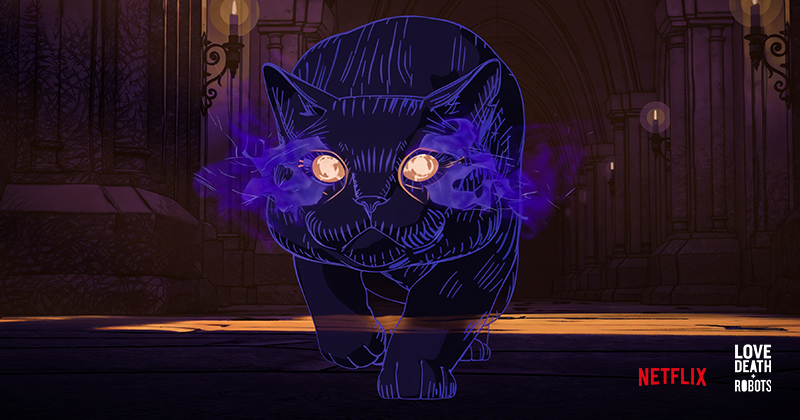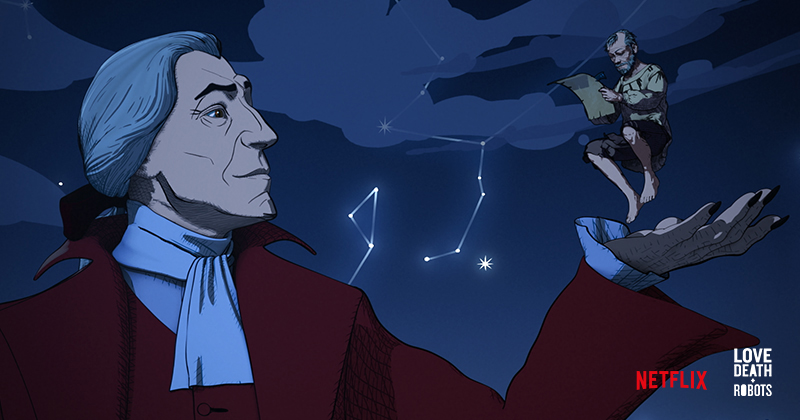


From self-expression to commercial success
Photos courtesy of Netflix and by Kathy F. Atkinson November 10, 2025
UD faculty member shares lessons learned from writing for the entertainment industry
After selling the rights to her short story, “For He Can Creep,” to Blur Studios for the Netflix series Love, Death & Robots, Siobhan Carroll heard nothing for about three years. Just like any regular viewer, the associate professor in the University of Delaware Department of English watched the episode when it premiered in May 2025.
“I was not involved,” she said. “I signed off on the rights, and I got to see it when it premiered, and that’s pretty typical for a lot of film and TV.”
Carroll began working with Blur a few years ago as a consulting writer for the Amazon Prime series Secret Level, which sets stories in the worlds of various digital games.

“They had come across my fiction and thought I’d be a good fit for the series,” she said.
She wrote “The Company We Keep,” based on the The Outer Worlds video game produced by Obsidian Entertainment.
She was inspired to write “For He Can Creep” by a line of poetry she read as a student, and she developed the story of a cat fighting the devil during a writing retreat in 2018. Seeing her work adapted to the screen, Carroll reflected on collaborative, commercial aspects of writing.
Reaching new audiences
Carroll’s research focuses on British literature from 1750-1850, including the era of Romanticism, and her short stories delve into fantasy and modern science fiction. Her work has been published in Northern Nights, a collection of Canadian horror stories, Asimov’s Science Fiction Magazine and the anthology of monster stories Screams from the Dark.
Having her story appear on Love, Death & Robots has brought Carroll a new audience.
“I’ve had people reach out to me to say they’ve discovered my work through this,” she said. “They’ve enjoyed it, and they’re going to keep reading it. That’s exciting.”
While Carroll hasn’t consciously changed her writing style with an eye toward development, she said it’s hard not to think about how stories get filmed — or animated.
For example, Carroll sets a lot of her stories on water, because the depth, darkness and aquatic creatures can add elements of fear; however, production companies are afraid of filming on water for a completely different reason: It is expensive.
Creating special effects is cheaper in animation than live action, but on the other hand, crowd scenes are expensive to animate.
“These are things I’m more conscious of when I’m writing, but I also feel like you can’t really take them into account for artistic reasons,” Carroll said.
A lesson in collaboration
Working with Blur Studios has also impacted the way Carroll teaches creative writing courses at UD. While she has always focused assignments on helping students become successful writers in the traditional sense of having their work published as articles or books, she now includes lessons on teamwork, collaboration and intellectual property (IP).
“When you work with a company like Marvel Studios or the Muppets, there is both more collaboration and more restrictions than when you write for yourself,” she said.

She puts her students in teams with the task of developing a story pitch on an existing IP. For example, write a story about Batman, but it has to be at Christmas time, it can’t be set in Gotham and the Joker can’t be in it.
The exercise includes creative and business aspects of this type of writing. The students take time to familiarize themselves with the existing IP and the Writer’s Guild contract. They develop their pitch, present it to the class, then discuss what might happen next with the studio.
“Working with somebody else’s imagination, that’s a challenge,” she said. “How do you interest yourself in telling someone else’s story or developing their characters? What pushback might you receive?”
Carroll said that her students don’t come across this kind of creative group work often, but it is a realistic exercise.
“Particularly now, and particularly if you’re interested in working in Hollywood, there’s going to be a lot of creative collaboration that involves both creating shared stories and negotiating around restrictions,” she said.
A wonderful lightning storm
A practical change since working with Blur is that Carroll now has an agent who shops her stories to production companies, so she can focus on teaching, research and writing.
“I’m plugging along in my day-to-day life and occasionally I’ll get an email about a project or something happening in the next two weeks. It’s like being caught up in a wonderful lightning storm,” she said.
And despite venturing into this new realm of storytelling, she said the fundamentals of compelling writing remain the same.
“You always have to start with writing for self-expression,” she said. “The best writers, including the most commercially successful, start from that same place, and they figure out how to bring that element of self-expression into their commercial writing.”
This is also the human element of writing that AI can’t duplicate, at least yet.
“If what you write is animated by real human concerns, like loneliness, the desire for friends, fear of betrayal, loss of a loved one — that’s the fuel that runs the engine of stories, and that’s how you connect with readers,” she said.
Contact Us
Have a UDaily story idea?
Contact us at ocm@udel.edu
Members of the press
Contact us at mediarelations@udel.edu or visit the Media Relations website

